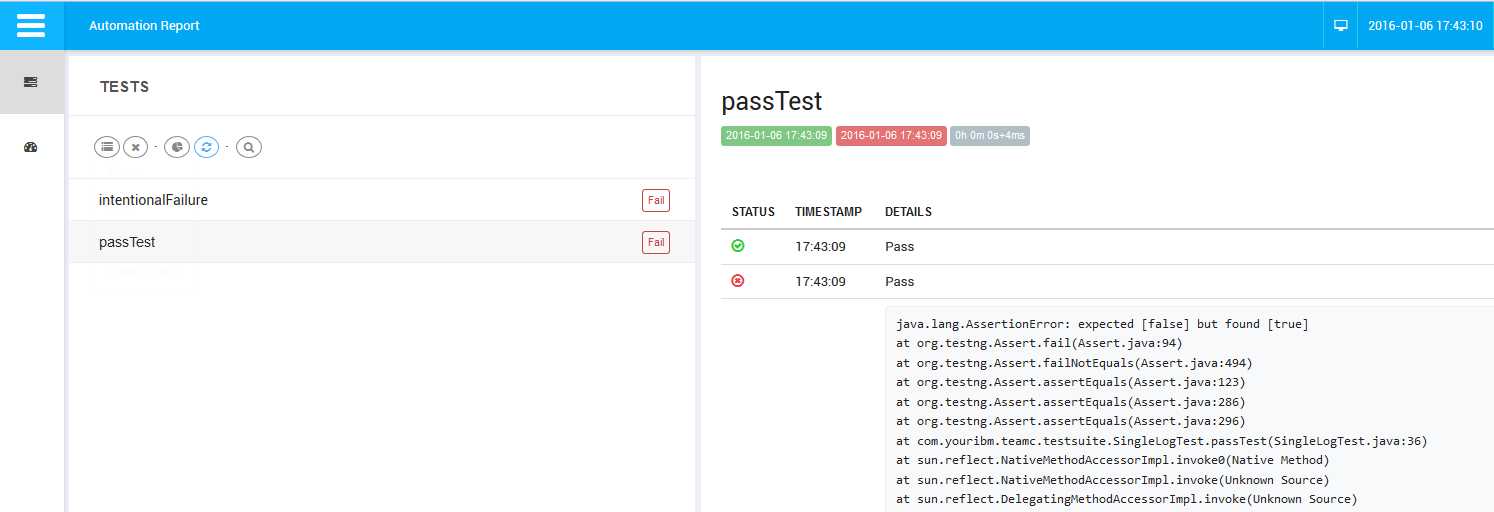标签:
通常来说如果需要看Selenium的运行报告无非以下几种:
1.Eclipse+Junit 这种最简单但是局限在于只能在Eclipse里看,这个就是用最原生的Junit单元测试框架
2.Junit+Ant 用Ant来驱动Selenium执行,会生成一个xml,通过xsl样式表来形成一个html的报告,报告比较全面,但是样式和内容的自定义能力比较差
3.Testng的报告,也是Html的格式
4.自定义的report,基本上用assert或者log来结合做一个report,直接写html标签来实现,这样的格式自定义比较强,但是需要编码功底,至于样式就看个人能力了
这里我推荐一个jar包 Extentreport 基于这个jar包来生成的html不仅美观而且可读取强,如果不满意里面的排列和内容还可以自定义,是个生成html report的利器
首先是下jar包,网上搜一下就有了extentreports-java-2.40.0.jar 这里需要下连java源文件也带上的 方便我们自定义report
然后新建一个class文件,这里我直接贴一个例子上来
import com.relevantcodes.extentreports.DisplayOrder;
import com.relevantcodes.extentreports.ExtentReports;
import com.relevantcodes.extentreports.ExtentTest;
import com.relevantcodes.extentreports.LogStatus;
import com.relevantcodes.extentreports.NetworkMode;
public class ExtenseReport {
static ExtentReports extent;
static String reportLocation = "report/ExtentReport.html";
static String imageLocation = "../img/Feedback.png";
private ExtentReports createReport() {
return extent;
}
public static void main(String[] args) {
// TODO Auto-generated method stub
extent = new ExtentReports(reportLocation, NetworkMode.OFFLINE);
String img = test.addScreenCapture(imageLocation);
test.log(LogStatus.INFO, "Image", "Image example: " + img);
extent.endTest(test);
ExtentTest test2 = extent.startTest("My First Test", "Sample description");
String aimg = test2.addScreenCapture(imageLocation);
System.out.println(img);
test2.log(LogStatus.INFO, "Image", "Image example: " + aimg);
extent.endTest(test2);
extent.flush();
}
}
上面贴的是2个测试用例,用例里包含正确和错误的测试用例以及把图片贴进去的例子,这个是单纯的没有用到测试框架的例子
下面列举一个用到了Testng的例子
public class SingleLogTest extends BaseExample { private final String filePath = "file-path.html"; @BeforeClass public void beforeClass() { extent = new ExtentReports(filePath, true); extent.startReporter(ReporterType.DB, "extent.db"); extent.addSystemInfo("Host Name", "Anshoo"); } @Test public void passTest() { test = extent.startTest("passTest"); test.log(LogStatus.PASS, "Pass"); Assert.assertEquals(test.getRunStatus(), LogStatus.PASS); } @Test public void intentionalFailure() { test = extent.startTest("intentionalFailure"); test.log(LogStatus.FAIL, "Fail"); Assert.assertEquals(test.getRunStatus(), LogStatus.PASS); } }public abstract class BaseExample { protected ExtentReports extent; protected ExtentTest test; @AfterMethod protected void afterEachTest(ITestResult result) { if (!result.isSuccess()) { test.log(LogStatus.FAIL, result.getThrowable()); } extent.endTest(test); extent.flush(); } @AfterSuite protected void afterSuite() { extent.close(); } }
这里说明一下就是因为Testng里面有Assert,而这个Assert的结果是无法直接输送到report里的,所以就要用到@AfterMethod来获取到每次执行的@Test中的结果来人为的把这个结果人为输送到report中去。
贴一下最后生成的结果,感觉还是不错的,之后继续尝试着修改这个jar来符合我们自己想要的样式。

Selenium生成Report的利器 - ExtentReports
标签:
原文地址:http://www.cnblogs.com/goldenRazor/p/5106466.html